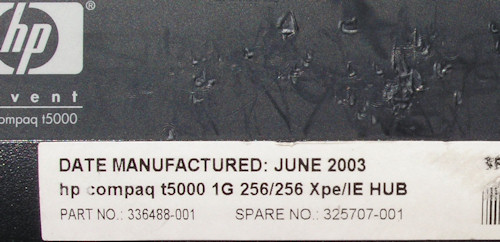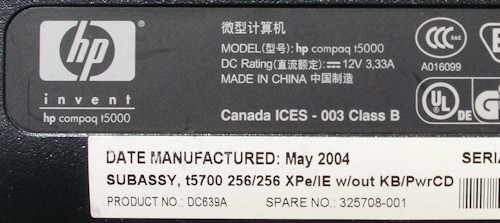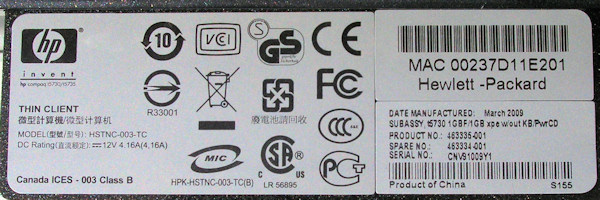This page is a (brief) summary of information on HP thin clients. It's come either from thin clients I've seen or from the web. It's not guaranteed to be 100% accurate. If you find any errors please let me know.
HP thin clients proliferate under the umbrella name of the T5000 series and are occasionally sold as " ...a T5000". A glance at the labelling section below might explain this. You do need to check the small print to see what you've got. If you arrived here to find details on a T5000 1G you need to move on to here.
On the support page of the HP website there is a long list of HP thin clients. There appear to be 25 models in the T5000 series, some under the 'HP Compaq' name, some under the 'HP' name.
HP Compaq: t5125, t5135, t5300, t5500, t5510, t5515, t5520, t5525, t5530, t5700, t5710, t5720, t5725, t5730, t5730w, t5735
HP: t5145, t5325, t5540, t5545, t5630, t5630w, t5740, t5740e, t5745
I originally wrote: "I have not attempted to fathom out HP's naming scheme..." but since then I have received the following explanation from Benjamin Gawert:
The t in the model number stands for "thin client". There also are models which use st (e.g. st5742) which stands for "streaming thin client". These are based on the same hardware as the t models but with no flash Disk-on-Module (DOM) (they use a streamed OS which is loaded over the network). And then there are the gt models which are "graphics thin clients" (meant as local graphics terminals connected to a Blade Workstation). These use different, more powerful hardware than the other thin client models.
Following the initial letter(s):
The first number is always 5 for thin clients and 7 for graphics terminals.
The second number stands for the model range:
3 = entry level
5 = mainstream models (midrange models)
6/7 = flexible models (high end models).
The third number tells you the sub-model and the generation of this specific model range.
The fourth number defines the operating system:
0 = Windows (CE, XPe, WES)
5 = Linux
2 = No OS (the st series).
For some Windows-based models, there also is another lower-case letter after the fourth number to differentiate between the various Embedded versions of Windows (not CE). For example, the t5560 runs Windows XPe while the t5560w runs Windows Embedded Standard (WES) 2009. Similarly, the t5740 runs WES 2009 while the t5740e runs the new Windows Embedded 7 Standard. The hardware is identical, only differing in RAM size, flash size of the DOM, and the OS type encoded in the BIOS.
t5540, t5545, t5560 and t5560w are identical hardware-wise and only differ in RAM size, DOM size and OS type. t5540 runs Windows CE, t5545 runs Linux, t5560 runs XPe and t5560w runs WES.
The same is true for these models as well:
- t5550 (Windows CE), t5565 (Linux) and t5670 (XPe)
- t5730 (XPe), t5735 (Linux) and t5730w (WES)
- t5740 (WES), t5740e (WE7), t5745 (Linux) and st5742 (no OS)
There also is a t5145. It was a low cost model and some kind of predecessor of the st models and had a very small DOM (128MB) containing a small Linux system. It could run as a regular thin client or as streaming client. The hardware is identical to the t5540/5545/5560 models but the CPU only runs at 500MHz instead of 1GHz.
For second hand buyers who want such a device for a project (not as a standard thin client) it is usually cheaper to look for the Linux variant of the specific series that he/she is interested in as the variants running Windows tend to go for much more (especially the ones running WES). Also, if someone intends to replace the DOM with something else, it may be better to go for the streaming models (st) instead as they contain no DOM. For example, the current t5740 with Atom CPU, DDR3 and DisplayPort is terribly expensive. A st5742 which uses the same hardware but lacks the SATA DOM can be had for a lot less.
Thank you Ben for such a comprehensive explanation.
The table below provides some basic data on the models that often appear on ebay and can sell for not-a-lot. (Other than the T5530 - which came with a 4GB CF card, CF-IDE adaptor and cable, and the T5730, the ones I've bought have been less than £10, usually in the range 99p-£5 plus p&p).
| Model | product | Case style | Processor | Speed | Memory | USB | PS/2 | OS | |||
|---|---|---|---|---|---|---|---|---|---|---|---|
| Flash | RAM | ||||||||||
| T5125 | 1 | VIA Eden | 400MHz | 32MB | 128MB | 4 x USB2.0 | 1 | Linux 2.4 | |||
| T5300 | DC643A | 1 | Transmeta Crusoe TM5600 | 533MHz | 32MB | DOM | 64MB | fixed | 4 x USB1.1 | none | CE.NET V4.2 |
| T5520 | 1 | VIA Eden | 800MHz | 64MB | DOM | 128MB | fixed | 4 x USB2.0 | 1 | Windows CE5.0 | |
| T5530 | 436673-001 | 2 | VIA C7 | 800MHz | 64MB | DOM | 128MB | fixed | 8 x USB2.0 | 2 | Windows CE 6.0 |
| T5700 | DC640A | 1 | Transmeta Crusoe TM5800 | 1GHz | 192MB | DOM | 256MB | SODIMM | 4 x USB1.1 | none | XPe SP1 |
| DC639A | 1 | Transmeta Crusoe TM5800 | 1GHz | 256MB | DOM | 256MB | SODIMM | 4 x USB1.1 | none | XPe SP1 | |
| DS435A | 1 | Transmeta Crusoe TM5800 | 733MHz | 192MB | DOM | 256MB | SODIMM | 4 x USB1.1 | none | XPe SP1 | |
| T5720 | 3 | AMD Geode NX 1500 | 1GHz | 1GB | 512MB | 6 x USB2.0 | 2 | Windows XPe SP2 | |||
| T5725 | 3 | AMD Geode NX 1500 | 1GHz | 512MB | 256MB | 6 x USB2.0 | 2 | Debian Linux 3.1 | |||
| T5730 | 4 | AMD Sempron 2100+ | 1GHz | 1GB | DOM | 1GB | SODIMM | 6 x USB2.0 | 2 | Windows XPe SP3 | |
As far as I'm aware the flash in all models is a DiskOnModule (DOM) plugged in to a 44-pin IDE interface. This means it is easy to fit alternative storage - either larger DOMs, Compact Flash cards or even a disk drive.
It's a different case with the RAM. In some cases it is soldered to the motherboard so you're stuck with what ever is there. In other cases it is a SODIMM and so can be swapped for a larger sized SODIMM should you wish to do this.
 So far I've come across the four basic styles shown in the photo. From left to right I'll designate these 1,2,3 and 4.
So far I've come across the four basic styles shown in the photo. From left to right I'll designate these 1,2,3 and 4.
1 is the old T5000 series.
2 is the later(?) model. (eg T5530)
3 is another later(?) model. (eg T5720)
3 is the latest(?) model. (eg T5730)
The labelling of the T5000 series has changed over the years. Here are some examples:
 This is label from the first thin client I got hold of - it is also the one with earliest manufacturing date.
It identifies itself as a T5000 1G with a part number of 336448-001.
HP must have subsequently revamped their numbering scheme as this hardware is identical to the T5700.
(See next label).
This is label from the first thin client I got hold of - it is also the one with earliest manufacturing date.
It identifies itself as a T5000 1G with a part number of 336448-001.
HP must have subsequently revamped their numbering scheme as this hardware is identical to the T5700.
(See next label).
 About a year later we have the T5700. The details on the labels have now changed. We now have:
About a year later we have the T5700. The details on the labels have now changed. We now have:
Model : hp compaq t5000
SUBASSY : t5700
Product : DC639A
 With the 5530 (3 years on from the above) we have:
With the 5530 (3 years on from the above) we have:
Model: HSTNC-002L-TC
SUBASSY : t5530
Product : 436673-001
 With the 5730 (1 year on from the above) we have:
With the 5730 (1 year on from the above) we have:
Model: HSTNC-003-TC
SUBASSY : t5730
Product : 463335-001